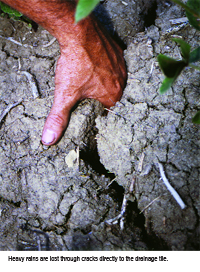
Features
Agronomy
Soil
An idea takes off
Controlled drainage can improve yield, reduce environmental impact.
November 23, 2007 By Peter Darbishire
 A representative group of farmers and conservation related people in the Lambton County region of Ontario are keen to evaluate controlled drainage systems as a way to reduce nutrient flow away from agricultural land while retaining valuable moisture for crop production.
A representative group of farmers and conservation related people in the Lambton County region of Ontario are keen to evaluate controlled drainage systems as a way to reduce nutrient flow away from agricultural land while retaining valuable moisture for crop production.
The RLS (Rural Lambton Stewardship) Network believe controlled drainage is an ideal solution for the heavy clay soils near the St. Clair River, which divides Ontario and Michigan, taking flow from the upper Great Lakes of Superior, Michigan and Huron.
Doug McGee, who farms at Port Lambton, is hoping one of his farms will be used as a pilot project which can be used to monitor performance. The Ontario Ministry of Agriculture, Food and Rural Affairs and the Lambton Soil and Crop Association, along with the St. Clair River Conservation Authority, the Ontario Ministry of Natural Resources and Friends of a Feather are all party to the project.
The farm is 138 acres and is drained by laterals that connect to two main drains, each serving 48 acres and 90 acres. Laterals are spaced at 50 feet, but McGee plans to split these to 25 feet. The farm has little slope and with strategically placed control structures in the two mains, the site can be used to monitor outflow for various scenarios using different treatments of fertility, manure application, controlled drainage and free drainage, and possibly even subirrigating using water from the St. Clair River.
Controlled drainage itself interests McGee. “When this heavy Brookston and Caster clay soil dries out we get deep cracks an inch or more across. If we have a one inch rain, most of the water goes straight to the tile and it’s lost. Controlled drainage would reduce this loss,” he says. “If we put 160 pounds per acre of nitrogen on our corn crop and some is lost in a half inch rain, we’ve lost the nitrogen and haven’t gained yield.”
Initially, McGee says two control structures are being planned, plus six water table monitoring stations. “They will be providing a hydrology study for the whole field, including monitoring water inflow below the surface,” he says.
“This is a little idea that’s become a big project,” says McGee. “We hope we can provide some benefit from a water quality standpoint.” He is cautious to note, however, that “Data alone don’t make ideas like this take off: farmers doing them make ideas take off.”